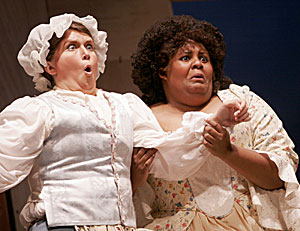 |
|
Evan Caravelli / Arizona Daily Wildcat
|
Rachel Kuhn (left) plays Susanna and Audra Scott (right) plays Countess Almaviva in the University of Arizona Opera Theter's production of the Mozart masterpiece "Le Nozze di Figaro." The opera opens today and tickets are $10-15.
|
|
|
By Nathan Tafoya
Arizona Daily Wildcat
Thursday, November 18, 2004
Print this
Opera packs more drama than a week of your favorite soaps
Che Guevara. Patrick Henry. Spartacus. Wolfgang Amadeus Mozart. There is a connection. Sort of. This weekend, the University of Arizona Opera Theater will present the fully staged Mozart masterpiece "Le Nozze di Figaro" ("The Marriage of Figaro"). The opera was first performed in Vienna on May 1, 1786.
The opera was based on a play by Pierre Beaumarchais, which was written before the French Revolution and banned in Paris for its revolutionary ideas. "Le Nozze di Figaro" follows the adventures of a comical servant, Figaro, as he outwits and traps an aristocratic count who wants his woman.
The story takes place near Seville, Spain, in 1778, where Figaro's plans for marriage to Susanna, the countess' maid, are curtailed by the count's attraction to Susanna. What unfolds is Figaro's plan to unveil the horny count. ˇViva la revolución!
If you go... | Le Nozze di Figaro
Nov. 18-20,
7:30 p.m.,
Nov. 21, 3p.m.
Crowder Hall
$10-15
Box Office: 621-1162
MusiCall: 621-2998 |
|
The Italian opera is a roller coaster of plot mishaps, popular melodies and emotional misunderstandings as the music staccatos in accordance to an actor's anger in one scene and then crescendos euphorically to convey amorous passion in another.
Performers said the opera was more taxing than most other types of performances because of the increased music difficulty and the constant singing, including singing what would usually be considered dialogue.
"You have to not only keep an aspect of speaking, but you also have to hit some notes," said Christopher Herrera, a voice graduate student who plays Figaro. "Whereas if you're speaking dialogue, which is hard in itself, this is an extra element added because there's pitches, there's notes added to that speaking part now, on top of everything else you have to say."
And none of the performers are fluent in Italian, according to Herrera.
"The way we learn it is, we spent like, I don't know how many weeks, just speaking it," said Herrera of the foreign-language opera. "Not singing, just speaking the whole opera. Trying to get the flavor of the language."
Members of the UA School of Music and Dance have spent months preparing for the opera. All of their efforts, though, will culminate in only two, three-hour performances before a live audience.
"All that work for two shots," said Herrera.
But there can be an upside to performing only twice.
"You can't get worn out, because you don't have time to," said music education senior Rachel Kuhn, who plays Susanna. "But at the end, it's kind of a letdown sometimes."
Herrera said it's probably good the opera is only one weekend because of the holiday break and approaching finals.
And UA community members given to leaving performances before the end might want to reconsider this time around.
"The ensemble, the second act finale, I think is just an amazing piece of music," said Nathan Krueger, a doctoral student playing the Count. "Because you have six of us on stage weaving in and out. There's some really cool moments for everybody."
Though it is complex, Kuhn and Herrera agreed that musically and dramatically, the second-act finale is a favorite.
"Musically, Mozart just made it work," said Herrera. "Just 25 minutes of non-stop singing until the finish. And its part of the opera. That's only the finale of the second act."
There are other favorite moments for the performers, including their arias, or opera solos.
"For an opera singer that's like your whole night," said Herrera, explaining arias.
"My favorite parts are the duets," said Kuhn. "I do them with Cherubino where he jumps out the window, which is kind of exciting because it's extremely fast."
Kuhn also found a favorite character.
"I think my favorite part is the character Susanna herself because she's pretty much behind the whole plot," said Kuhn. "She's wheeling and dealing her way around and trying to make everything work out in the end because there's a whole lot of conflict going on."
She added that Le Nozze di Figaro is a good choice for opera beginners and those who want to do a little dilettantish theatre exploration.
"It's basically a soap opera in three hours," said Herrera.
So for a night (or matinee) of singing, dancing and costumes with people more talented than anyone that can be seen on "General Hospital" or "As the World Turns," Le Nozze di Figaro might be the place to be.
